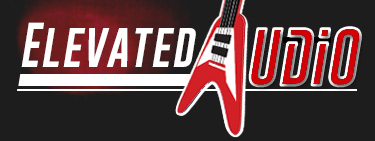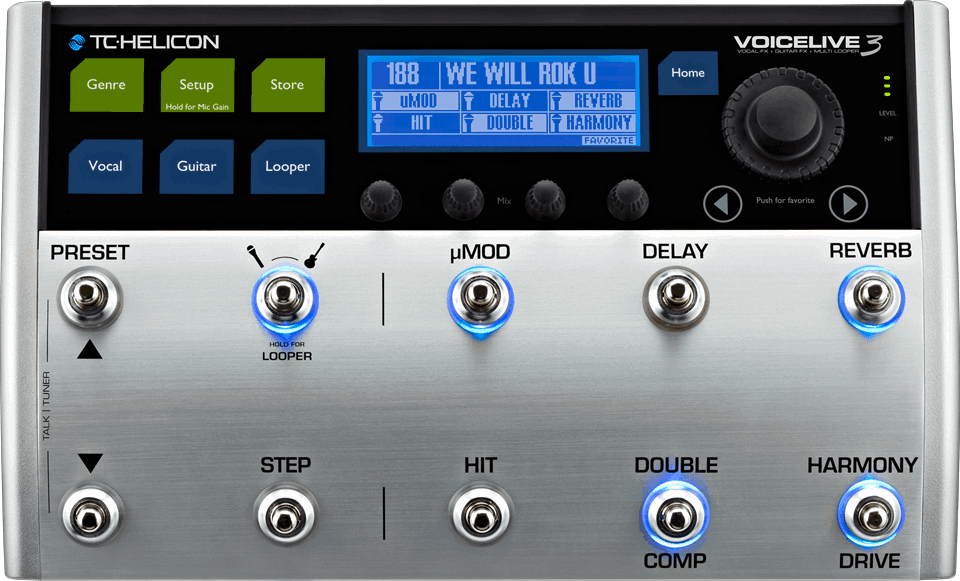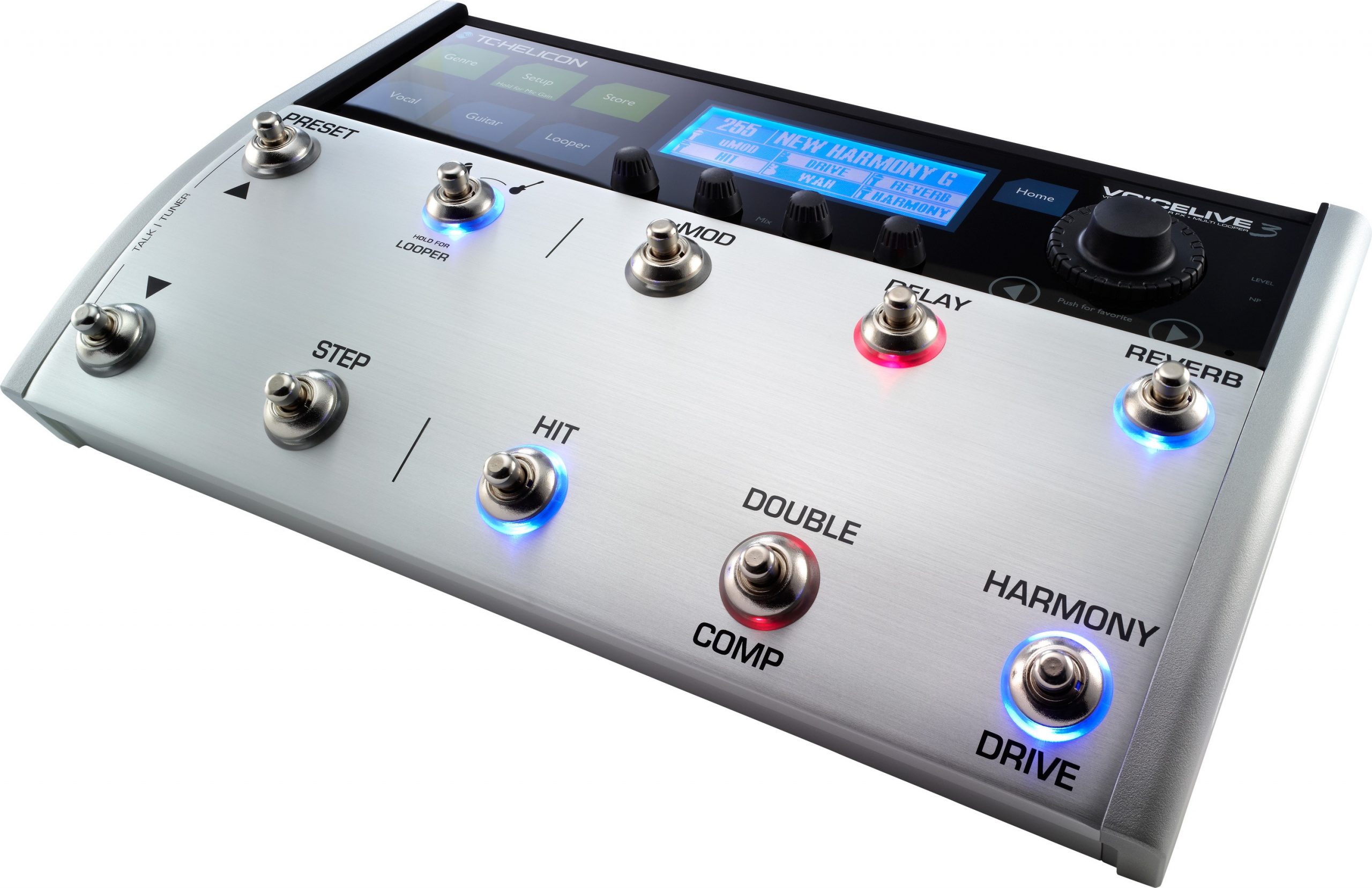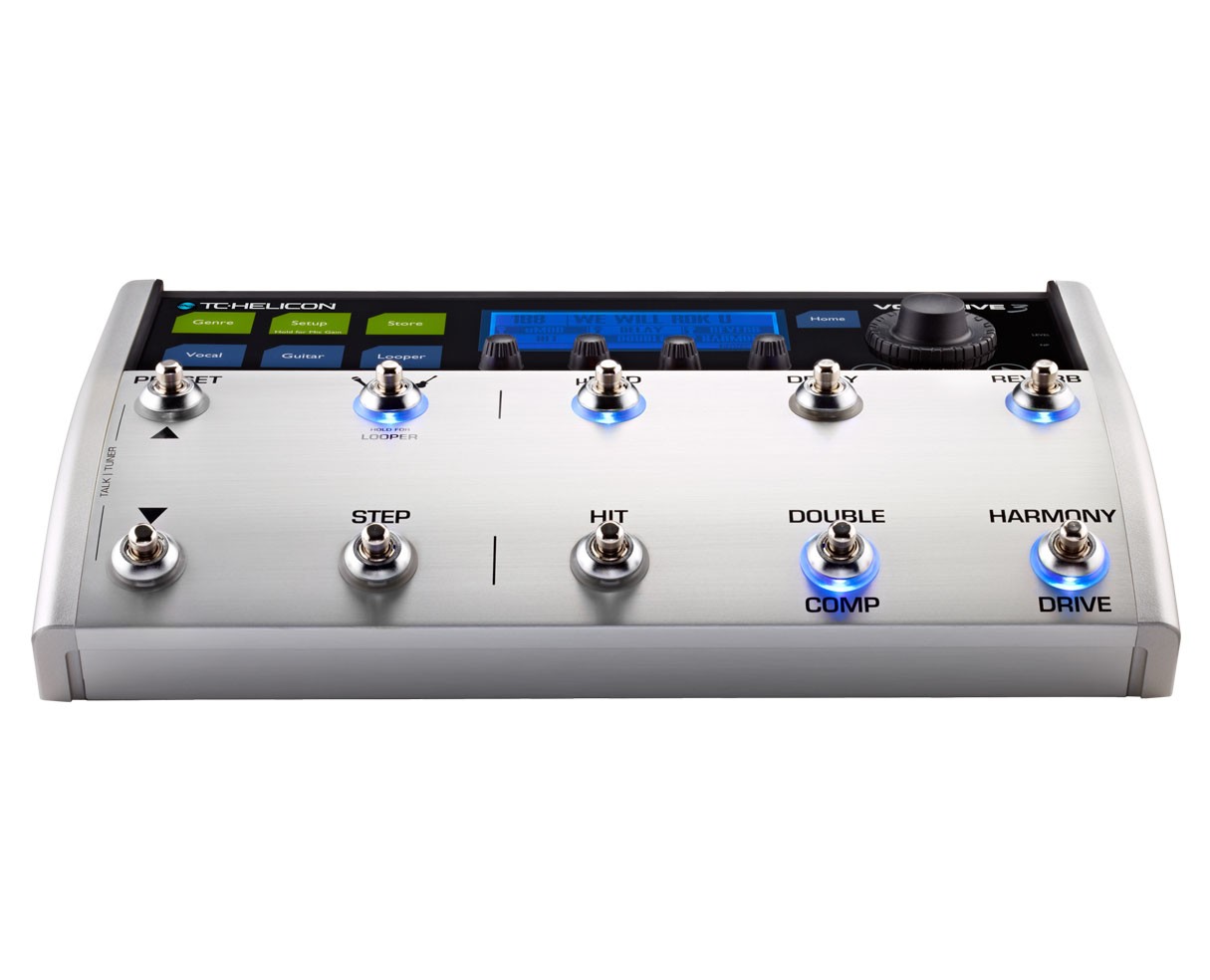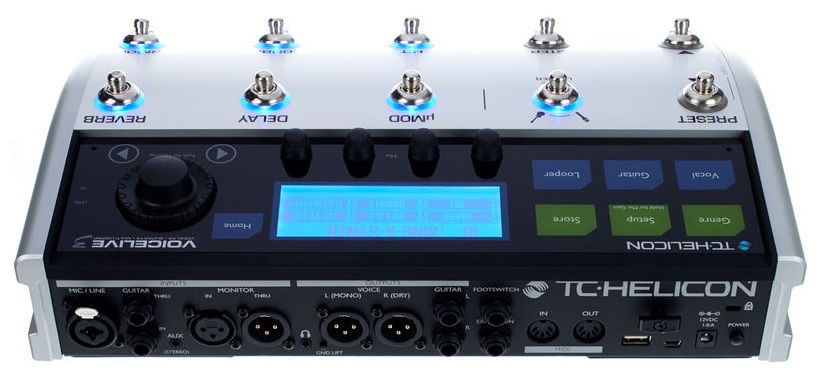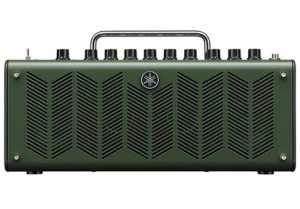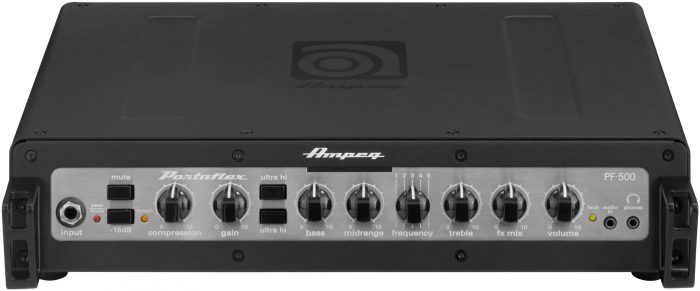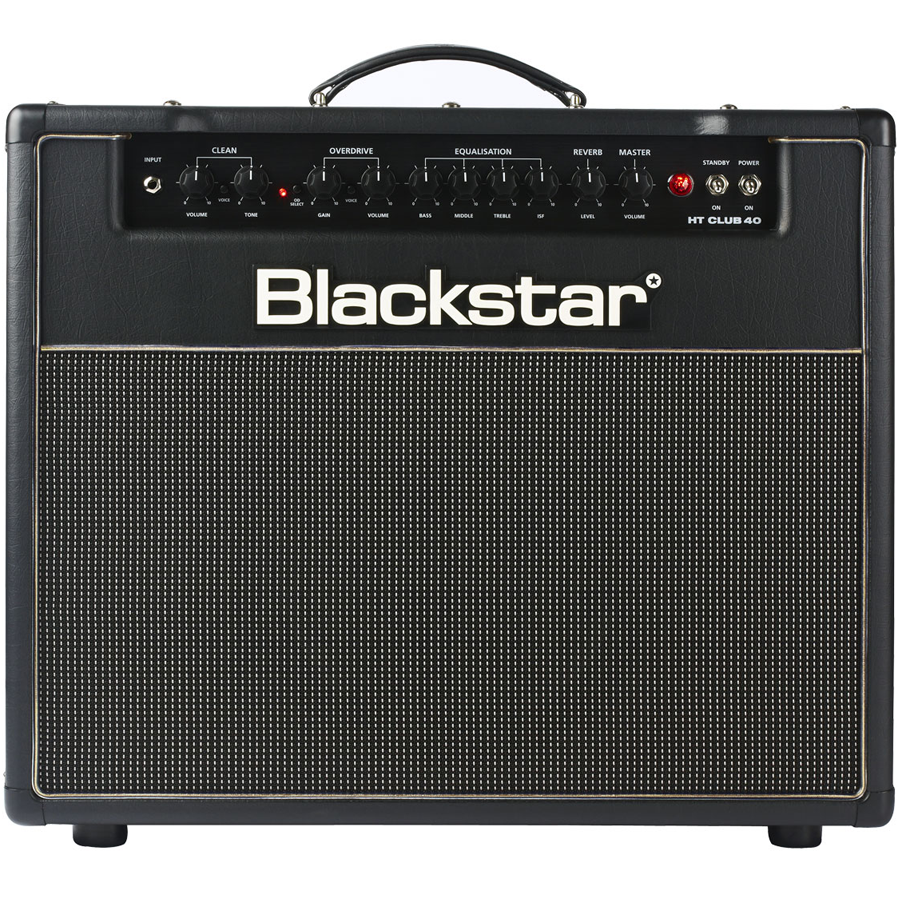


The Next Generation, Loaded with a Slew of New Stuff!
Previous incarnations of the VoiceLive series provided singers with a vehicle for enhancing their onstage performance by providing harmonies and effects that auto-track based on the chords being played. Whether solo or backed by a band, the VoiceLive opened up the creative possibilities of live performance. Now with the VoiceLive 3, TC-Helicon is upping the ante yet again, adding tons of new features to an already impressive system, making this version the ultimate performance tool.

What's New?
If you're at all familiar with the previous VoiceLive models, you already know about the huge amount of stuff TC-Helicon packed into stage-friendly boxes. Imagine having all of that — plus a bevy of enhancements and new features to make your onstage presence even more awesome. So what are these new features? Let's take a look at the big ones:
Expanded Harmony Options
TC-Helicon loaded the VoiceLive 3 with a trio of brand new Harmony modes, expanding the possibilities even further than the previous models. Here's a breakdown of what each of these new modes can do.
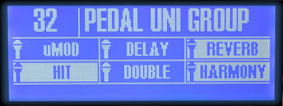 Pedal:
Pedal:
In this mode, VoiceLive 3 "sings" the root note of whatever chord you're playing. This can manifest itself as either the root above or the root below, depending on the chord. Sonically, you'll dig the way Pedal mode sounds when you're changing chords that have the same root note, as it just hangs onto that same note as you change chords and the melody moves.
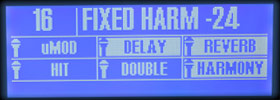 Fixed:
Fixed:
As its name implies, this mode holds a fixed user-defined note. No matter where your melody goes, the harmony will hold the same note the whole time. The note is defined by the key you've set +/- a number of semitones. Here is an example: If you've set the VoiceLive 3 to C and want the fixed note to be an E, you'd adjust the Fixed voice to +4. Not into math? The menu shows you both the numerical offset and the output note, so you can easily determine what the fixed harmony note will be.
 Mixed:
Mixed:
Designed for advanced users, Mixed Mode elevates the game. This mode gives you the ability to define the type of harmony the each voice will sing. So, for Voice 1, you could have it follow your guitar or keyboard (NaturalPlay), Voice 2 could work from a Key/Scale (Scale), Voice 3 could be a fixed note (Fixed), and Voice 4 could be a Pedal. As you can see, Mixed Mode offers a ton of options to add harmonies to your vocals.
 Domo Arigato... Well, You Know the Rest
Domo Arigato... Well, You Know the Rest
Let's face it: vocoders are just fun. They are a great way to spice up any vocal track or song. VoiceLive 3 is loaded with an awesome vocoder, giving you a voice-controlled polyphonic synth, plus robot modes you can use to twist and contort your voice into cool new sonic territories.
 Guitar FX Borrowed from TC Electronic TonePrint Pedals
Guitar FX Borrowed from TC Electronic TonePrint Pedals
Sure the VoiceLive 3 is aimed at adding to your onstage vocals, but it's also loaded with a selection of awesome guitar effects too. Borrowing from sister company TC Electronic, TC-Helicon dropped guitar effects from the super-cool TonePrint series into the VoiceLive 3. Among the choice effects available to you are samplings from the Flashback Delay, the Hall of Fame Reverb, the Corona Chorus, and others.
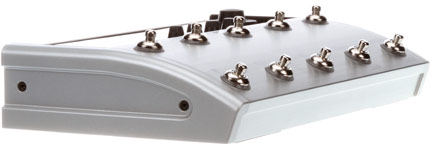 Even More New Effects
Even More New Effects
Also new this time around is a talkbox. Just talk into your mic, and your vocals come alive with Frampton-style vocal inflections. There's no hose involved, just classic talkbox sounds right at your toetips. Also new this time around is a wah effect, giving you funkified tones whenever you need them. These new sounds are just the tip of the sonic iceberg for the guitar sounds. We'll get into more later.
Sing It for Me!
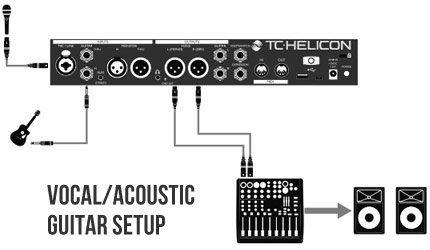
First and foremost, VoiceLive 3 is a vocal performance tool, and it has everything you need to shape and enhance your vocals in spades. Everything starts with a top-quality mic pre that automatically sets the gain for you. Just sing as loud as you're going to sing into your mic, and the VoiceLive 3 sets the gain accordingly. Say goodbye to distortion and overloads!
Virtually everything that made the VoiceLive 2 so incredible is here, including the ability to conjure tight, professional backing vocals with a toe tap. You have explicit control over how the harmonies are triggered, with the ability to conjure anything from a single voice to a passel of backup singers. These virtual voices track your song based on the chords you're playing — either tracking your guitar via the 1/4" input or your keyboard via the MIDI input — allowing them to always be in tune with you. And as stated above, the three new harmony options give you more choices than ever before, so you'll always have the right sound backing you up.
The Singing Guitarist's Best Friend!

Even if you took away all of the vocal and harmony processing power of the VoiceLive 3, it would still be a formidable guitar effects processor. The guitar effects path boasts a dedicated pair of hi-Z outputs for connecting to an amp (or amps, if running in stereo) or balanced outs for connecting to a PA or mixer. Onboard, you have access to the aforementioned TonePrint effects from TC Electronic, plus talkbox, chopper, bass, and wah effects. Long story short, you have everything you'd ever need to shape your guitar sound.
You can simplify your setup and leave your amp at home thanks to built-in amp emulation. Pick from amp tones ranging from classic British crunch to California-style tones and everything in between. Coupled with the onboard effects, these emulations make the VoiceLive 3 an impressive all-in-one guitar processor that can replace your amp and pedalboard all at once. As an added bonus, TC-Helicon is throwing in a guitar and headphone cable designed specifically to allow for in-ear monitoring for ampless practice.
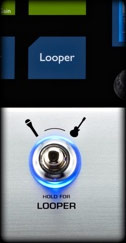 In the Loop
In the Loop
Especially for the solo performer, looping lets you build up a song by laying down rhythm and percussive tracks. Once you've gathered your loops, you can arrange and re-arrange the looped backing tracks with slick verse-chorus-bridge switching. If you struggle with keeping the timing of your loops tight, LoopAssist is here to help. A multipurpose metronome starts you off on the right foot, and then quantize syncs them up nicely. The VoiceLive 3 takes it a step further with auto expansion, which stretches or shrinks a loop to different lengths. This exponentially expands your looping capabilities, enhancing your performances.
 Anything You Need, Right Where You Want It
Anything You Need, Right Where You Want It
The Layers function brings everything together into a powerful performance tool. This lets you remap buttons, either within a layer (Vocal or Guitar, the looper is static) or between the Vocal and Guitar layer. From a user standpoint, this lets you reside in the Guitar layer while still having access to Vocal functions such as Harmony by simply remapping the Harmony button.
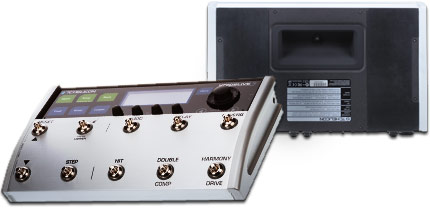 More than Meets the Eye
More than Meets the Eye
Under the hood, the VoiceLive 3 is sporting a new 3iC power platform, which means that the vocal, guitar, and looping processing are each individually controlled by its own processor core. Add to that increased memory and incredibly fast access, and the VoiceLive 3 is rocking more than twice the processing power of its predecessor. And believe us, you'll notice the difference onstage!
 Sound like a Star
Sound like a Star
A great performance is all about dynamics, and VoiceLive 3 lets you master your onstage dynamics. The HIT button puts you one touch away from adding effects layers to your vocals, your guitar, or both. A practical application would be to add distortion and harmonies for the chorus, adding excitement to your song and set.
Other Cool Features
There are literally hundreds of features that make the VoiceLive 3 such an awesome onstage tool, and we can't possibly do them all justice here. But here's a rundown of some of the remaining highlights that we're sure you'll find helpful in taking your performance to the next level.
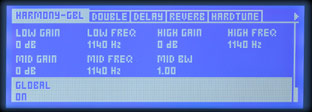 Global Presets
Global Presets
Say you want to use the same reverb (or any other effect) on all or a large number of your songs. Set the effect up in the Global preset and set the preset to "Global On" in any other preset that you want to use the effect on. Every preset where Global On is set will have that effect applied.
 Improved User Interface
Improved User Interface
Navigation through the VoiceLive 3 is as easy or in depth as you want it to be. Most users will be totally happy to reside in the top-level controls, where the LCD screen uses visual cues and knobs to control the "guts" of the effects. But pro users can go as deep into the rabbit hole as you see fit, as TC loaded the VoiceLive 3 with a ton of control options. We got an early release unit here at Sweetwater to check out, and believe us when we say you've got tons of options if you want to really dig into the VoiceLive 3.
In addition, a Genre feature lets you browse hundreds of presets by style, effects type, and artists. Find a genre that suits your style and VoiceLive 3 will list the presets that fit you. This is great for emulating the sound and feel of particular songs or artists.
 Hands-on Control
Hands-on Control
The optional MP-75 mic gives you additional control of presets, effects, and looping while you're performing.
 Auto-sensing Outputs
Auto-sensing Outputs
The VoiceLive 3 has a neat trick hiding up its sleeve that many casual users may not ever discover: auto-sensing jacks. When both balanced outputs have cables plugged into them, a stereo signal comprised of both vocal and guitar is passed to the PA. Plug a 1/4" cable into the guitar output(s) and plug that into your amp. The guitar signal is removed from the balanced output, and summed and switched to the guitar output. Pretty nifty!
INCLUDED EFFECTS
Vocal Effects: µMod, Echo & Delay, Reverb, Harmony, Double, Transducer, Rhythmic, HardTune + Correction, Choir, Stutter, Vocoder, Adaptive Tone
Guitar FX: Amp Modeling, Drive, Delay, Reverb, Compression, Resonant Filter, Wah, µMod (Flange, Chorus, De-tune), Shifter, Rhythmic/Tremolo, Talkbox (part of Vocoder)
CONTROL:
- 250 factory presets, Memory for 500 presets, 10 steps per preset, 10 footswitches, 6 preset-assignable footswitches for enabling/disabling FX blocks, Detailed editing, Genre and Styles preset categories
DESIGN:
Height: 3 inches (76mm)
Width: 13.8 inches (350 mm)
Depth: 8.5 inches (216 mm)
Weight: 5 lb. (2.3 kg)
Construction:
- Anodized extruded aluminum and steel chassis
- Rubberized edit/mix knobs
- Recessed rubberized handle
- 192 x 64 Blue STN LCD, white back light display
- Tri-colored Footswitch Light ring
- Capacitive touch edit controls with LED indicators
CONNECTIONS
ANALOG INPUTS:
VOICE
Connector: Combo Balanced XLR/Balanced TRS 1/4″ phone jack
Input Impedance Balanced: 3.08 kOhm
Mic Input Level @ 0 dBFS: -52 dBu to +7 dBu
Line Input Level @0dBFS: -40 dBu to +19 dBu
EIN @ Max Mic Gain Rg = 150 Ohm: -127 dBu
Mic SNR: >100 dB at typical Mic Input gain
Phantom Power: +48V (on/off via setup menu)
A to D Conversion: 24 Bit, 128 x oversampling bitstream, 110 dB SNR A-weighted
GUITAR
Connector: 1/4″ phone jack
Guitar Input Impedance: 1 MOhm
Guitar Input Level @ 0 dBFS: -2 dBU to 14 dBu
Guitar Input SNR: >108 dB
A to D Conversion: 24 Bit, 128 x oversampling bitstream, 110 dB SNR A-weighted
MONITOR
Connector: Balanced XLR
Input Impedance Balanced: 25 kOhm
Monitor Input Level @ 0 dBFS: +16 dBu
AUX
Aux: 1/8″ stereo mini jack
Aux Input Level @ 0 dBFS: +2 dBu
ANALOG OUTPUTS:
VOICE
Connectors: balanced XLR
Output Impedance Balanced/Unbalanced: 300/150 Ohm
Output Range: 0 dBFS Line Level: +14 dBu; Mic Level: – 2dBu
Dynamic Range: >109 dB, 20 Hz to 20 kHz/li>
Frequency Response: +0/-0.3 dB, 20 Hz to 20 kHz
D to A Conversion: 24 Bit, 128 x oversampling bitstream, 115 dB SNR A-weighted
GUITAR
Connectors: 1/4″ TRS phone jack
Output Impedance Balanced/Unbalanced: 442/221 Ohm
Output Range: 0 dBFS Line Level: +14 dBu; Mic Level: – 2dBu
Dynamic Range: >105 dB, 20 Hz to 20 kHz note
D to A Conversion: 24 Bit, 128 x oversampling bitstream, 106 dB SNR A-weighted
HEADPHONE
1/8″ Mini stereo jack, 50 Ohm, +14 dBu max
GUITAR THRU
Buffered Guitar Input
Connector: 1/4″ TRS phone jack
Output Impedance Bal/UnBal: 270/540 Ohms
MONITOR THRU
Direct connection to Monitor input
Connector: Balanced XLR
CONTROL:
USB: USB A, Mini-B
MIDI: In/Out: 5 Pin DIN
Pedal: 1/4″ TRS phone jack
Mic Control using TC-Helicon MP-75 Microphone or Sennheiser e 835 fx mic
SAFETY AND REGULATIONS
POWER:
External Power Supply Mains Voltage: 100 to 240 VAC, 50 to 60 Hz (auto-select)
Power Consumption: < 14 W
SAFETY:
EMC – Complies with: EN 55103-1:2009, EN 55103-2:2009, FCC CFR 47 Part 15B and ICES-003:2004 4th Ed
Safety – certified to: IEC 65, EN 60065, UL6500 and CSA IEC 65, EN 60065, UL6500 and CSA
ENVIRONMENT:
Operating Temperature: 32° F to 122° F (0° C to 50° C)
Storage Temperature: -22° F to 167° F (-30° C to 70° C)
Humidity: Max. 90 % non-condensing
WHAT'S IN THE BOX?
- Region specific power supply
- USB Cable
- Quickstart Guide
- Guitar/Headphone combo cable
Various
